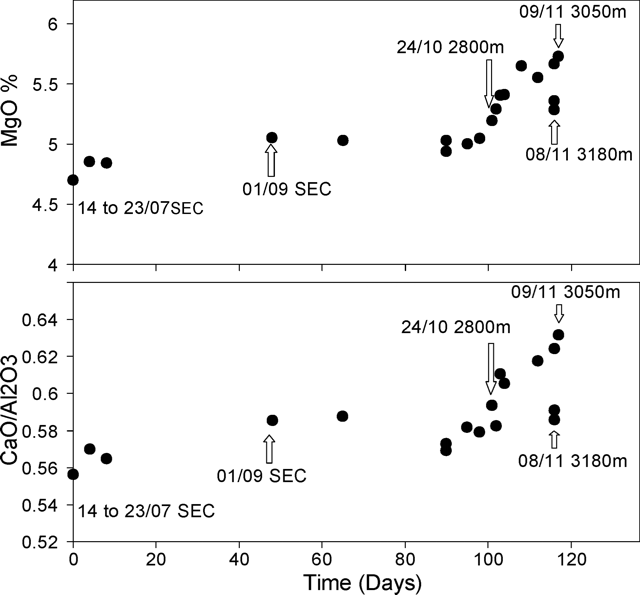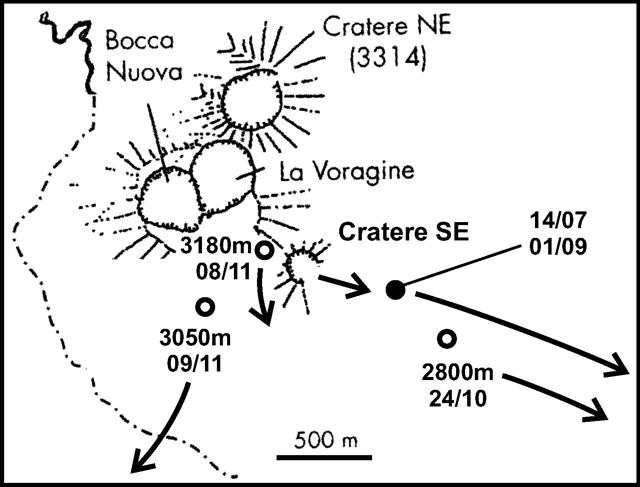Report on Etna (Italy) — December 2006
Bulletin of the Global Volcanism Network, vol. 31, no. 12 (December 2006)
Managing Editor: Richard Wunderman.
Etna (Italy) Changing lava chemistry after 24 October 2006
Please cite this report as:
Global Volcanism Program, 2006. Report on Etna (Italy) (Wunderman, R., ed.). Bulletin of the Global Volcanism Network, 31:12. Smithsonian Institution. https://doi.org/10.5479/si.GVP.BGVN200612-211060
Etna
Italy
37.748°N, 14.999°E; summit elev. 3357 m
All times are local (unless otherwise noted)
Roberto Clocchiatti and colleagues have provided information on the chemical composition of Etna lavas discharged during the recent eruptive period. Results of 18 major-element analyses on lavas erupted beginning 24 October 2006 are presented below.
The violent 2001 and 2002-2003 flank eruptions were fed by both trachybasaltic ("hawaiite") and basaltic magmas from various erupting vents (e.g. Clocchiatti and others, 2004). Conversely, the summit activity resuming from September 2004 to March 2005 produced only trachybasalt, which came from the upper levels of the magmatic system (Corsaro and Miraglia, 2005). After 16 months of calm characterized by mild gas venting, new lava emission began on 14 July 2006 at the summit SE Crater (SEC), lasting 10 days (BGVN 31:07). Since 31 August the SEC area exhibited a number of Strombolian episodes and lava flows, either from the SEC cone itself or from fissure vents which opened eastward at 2,800 m elevation (13 October), then southward at 3,000 m (23, 25 October), and finally westward at 3,050 m (26 October) and 3,180 m (8 November, internal reports from the INGV-Catania and the Omega-Acireale observatory) (figure 115).
Whole-rock analyses from 24 October onward show a significant increase of the MgO content and of the CaO/Al2O3 ratio (figure 116). The higher MgO and CaO, as compared to lower Al2O3 and alkalis, indicate a larger content of olivine and Ca-rich clinopyroxene at the expense of less plagioclase, so that the last analyzed lava is very close to a basalt composition (5.7% MgO, 10.7% CaO, 11.6% total Fe as Fe2O3, and 5.8% Na2O + K2O).
 |
Figure 116. Plots showing increases through time of the MgO content and the ratio of CaO to Al2O3 at Etna beginning on 24 October 2006. Courtesy of Roberto Clocchiatti and colleagues. |
References. Clocchiatti, R., Condomines, M., Guénot, N., and Tanguy, J.C., 2004, Magma changes at Mount Etna: the 2001 and 2002-2003 eruptions: Earth Planet. Sci. Lett. 226, p. 397-414.
Corsaro, R.A., and Miraglia, L., 2005, Dynamics of the 2004-2005 Mt. Etna effusive eruption as inferred from petrologic monitoring: Geophys. Res. Lett. vol. 32, L13302.
Geological Summary. Mount Etna, towering above Catania on the island of Sicily, has one of the world's longest documented records of volcanism, dating back to 1500 BCE. Historical lava flows of basaltic composition cover much of the surface of this massive volcano, whose edifice is the highest and most voluminous in Italy. The Mongibello stratovolcano, truncated by several small calderas, was constructed during the late Pleistocene and Holocene over an older shield volcano. The most prominent morphological feature of Etna is the Valle del Bove, a 5 x 10 km caldera open to the east. Two styles of eruptive activity typically occur, sometimes simultaneously. Persistent explosive eruptions, sometimes with minor lava emissions, take place from one or more summit craters. Flank vents, typically with higher effusion rates, are less frequently active and originate from fissures that open progressively downward from near the summit (usually accompanied by Strombolian eruptions at the upper end). Cinder cones are commonly constructed over the vents of lower-flank lava flows. Lava flows extend to the foot of the volcano on all sides and have reached the sea over a broad area on the SE flank.
Information Contacts: Roberto Clocchiatti, CEN Saclay, 91191 Gif-sur-Yvette Cedex, France; Gilles Chazot, Observatoire de Physique du Globe Clermont, 63038 Clermont Ferrand, France; Jean-Claude Tanguy, IPGP, Observatoire de St. Maur, 94107 St. Maur des Fossés, France; Giovanni Tringali, Osservatorio Meteorologico, Geodinamico e Ambientale (Omega), 95024 Acireale, Italy.


